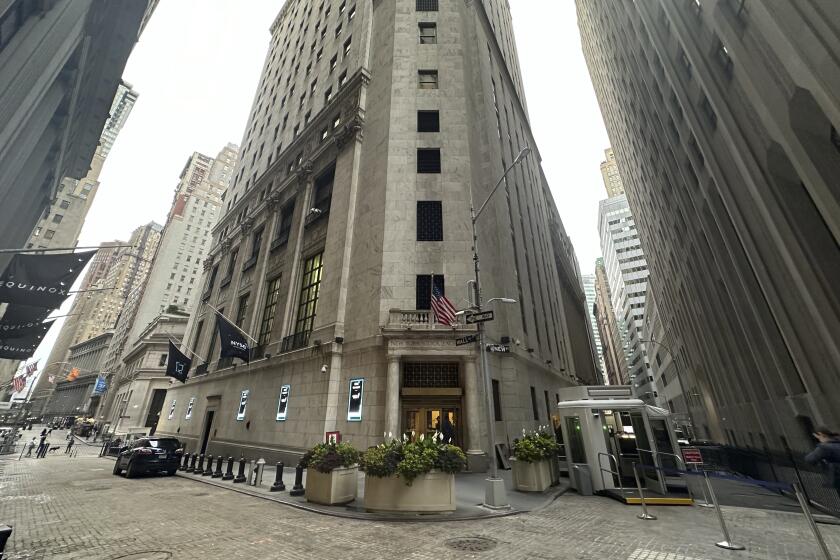Complex deals led to AIG’s undoing
For months, several executives at AIG Financial Products had pulled apart the data, looking for flaws in the logic. They kept asking themselves: Could this be right? What are we missing?
Their debate, in early 1998, centered on a consultant’s computer model and a new kind of contract known as a credit-default swap. For a fee, the firm essentially would insure a company’s corporate debt in case of default. The model showed that these swaps could be a moneymaker for the decade-old firm and its parent company, insurance giant American International Group, with a 99.85% chance of never having to pay out.
The computer model was based on years of historical data about the ups and downs of corporate debt, essentially the bonds that corporations sell to finance their operations. As AIG’s top executives and Tom Savage, the Financial Products president, understood the model’s projections, the U.S. economy would have to disintegrate into a full-blown depression for Financial Products to face having to cover defaults.
If that happened, the holders of swaps would almost certainly be wiped out, so how could they even collect? Financial Products would earn millions in fees for taking on infinitesimal risk.
The firm’s chief operating officer, Joseph Cassano, had studied the model and urged Savage to give the swaps a green light. “The models suggested that the risk was so remote that the fees were almost free money,” Savage said recently.
Initially, credit-default swaps would provide a fraction of Financial Products’ revenue that year. It didn’t seem like a big decision.
But all the upbeat predictions were wrong. The firm’s entry into credit-default swaps would evolve into insuring more volatile forms of debt, including the mortgage-backed securities that helped fuel the real estate boom now gone bust. It would expose AIG to more than $500 billion in liabilities and entangle financial institutions around the world.
When the housing market tanked, a statistically improbable chain of events began to unfold. Provisions in the swaps kicked in, spurring collateral calls on swaps linked to $80 billion in questionable assets, requiring the firm and AIG to come up with billions of dollars.
In September, the Bush administration concluded that AIG’s position at the nexus of the deals made it too important to be allowed to fail, triggering the most expensive rescue of a private company in U.S. history, $152 billion so far.
Credit-default swaps exemplify the contradictions of modern finance. They serve as insurance but aren’t regulated as such. They have allowed companies to free up capital that otherwise would be tied up as collateral for loans. They were sold both to reduce risk and, in some cases, to let clients take on more risk.
But, neither the buyers nor sellers truly understood the risks they were creating.
The very nature of credit-default swaps put Financial Products at odds with itself, requiring it to deviate from the disciplined system that made it a trailblazer. Everything about the firm -- its technology, its people, its culture of transparency and caution -- was designed to minimize risk while solving problems for clients.
That meant hedging -- making offsetting trades to balance risk -- whenever possible. For transactions involving credit and loans, it also meant building an escape route so that the firm could get out early if it saw a deal going bad.
With credit-default swaps, there was no way out, and the risk was so minute that hedging was considered unnecessary, as well as problematic.
AIG’s chairman, Maurice “Hank” Greenberg, had once warned Savage that he would come after him “with a pitchfork” if Financial Products did anything to harm AIG’s AAA credit rating, which gave Financial Products the ability to borrow big sums of money at the cheapest rates.
No one saw credit-default swaps as a large-scale venture. After talks that included AIG Vice Chairman Edward Matthews and other executives, Greenberg blessed the new line of business.
Greenberg said recently, “I don’t think going into it in ’98 was wrong.”
Savage says he now sees that the decision contradicted Financial Products’ guiding principles.
“The different nature of those trades from any other trades that FP had done opened the door to all the problems that came about,” Savage said. He added later: “In retrospect, perhaps those deals should never have been done.”
--
Back office climber
One of the firm’s biggest advocates for credit-default swaps was Cassano, who had worked with Financial Products’ three founders in their days at the junk-bond firm of Drexel Burnham Lambert.
A Brooklyn College graduate, Cassano had no expertise in the art of hedging. But he had excelled in accounting and credit -- the back office, as it is known on Wall Street.
The founders of Financial Products made him the firm’s chief financial officer. He was smart and aggressive, sometimes too aggressive, some executives thought. “He was very, very good,” recalled Matthews. “But he was arrogant.”
He also was ambitious. He made plain to his bosses that he wanted more than the back office, and in 1994 he got a chance.
The firm’s founders had left in a dispute with Greenberg, and Savage was handed the reins. He put Cassano in charge of the Transaction Development Group, a new unit hunting for business involving energy products and tax credits in the United States and abroad.
Cassano played a key role in the credit-default swap debate in the company. In 1998, when the investment bank JP Morgan Chase & Co. came to Financial Products seeking a credit-default swap deal, Cassano was among the most interested. He passed on that first deal but soon became a leading proponent.
JP Morgan wanted to package a variety of debt on its books and resell it. The debt would be turned into bond-like securities and layered like a wedding cake so investors in the top tiers would be the first to get back their money in case of default. Investors in lower tiers earned a higher rate of interest for taking greater risk.
The deal had the unwieldy name of Broad Index Secured Trust Offering, Bistro for short. Because the debt in Bistro was diverse, the investment was considered exceedingly safe; if one kind of debt went into default, it was unlikely other kinds would also go under at the same time. As an extra measure of safety, the Bistro organizers wanted Financial Products to write credit-default swaps on the top tiers to reassure investors.
As private contracts, deals like Bistro could be financed with greater amounts of borrowed money than regulators would allow if the debt were publicly traded. This high degree of leveraging would come back to haunt the industry.
The structure was an early form of collateralized debt obligations, which would become a key part of the 2008 economic meltdown.
--
‘The hardest thing’
By summer 1998, after four years as Financial Products’ president, Savage found himself thinking even harder about risk, particularly credit risk. It was often difficult to quantify the likelihood that someone would pay back a loan.
Derivative contracts were accounting for a greater share of the world’s financial activity each day. Some in Washington thought investors and regulators needed to know more about these private deals that were cloaked from outside scrutiny and clouded by complexity.
Brooksley Born, head of the Commodity Futures Trading Commission, argued forcefully for a public debate about whether derivatives posed a risk to the financial system. She testified at least 17 times before Congress on the subject.
Her campaign gained no traction. More powerful regulators, including Federal Reserve Chairman Alan Greenspan, Treasury Secretary Robert E. Rubin and Securities and Exchange Commission Chairman Arthur Levitt, opposed Born. They and others said that her agency had no authority over derivatives and that her call for action was casting a “shadow of regulatory uncertainty over an otherwise thriving market.”
Greenspan pushed the idea that the marketplace was self-correcting, a view that he often espoused in speeches at economic conferences. He invited Greenberg to attend one such meeting in Basel, Switzerland. Greenberg couldn’t go, so he arranged for Savage to go.
The question Greenspan posed that day resonated with Savage for a long time.
“Do you folks find that you have enough information to make credit decisions in your businesses?” Greenspan asked.
Mathis Cabiallavetta, chairman of the board for the giant Swiss bank UBS, responded that his company knew well what it was up against.
Not well enough, as soon became clear.
In September 1998, Long Term Capital Management, a heavily leveraged hedge fund with mountains of derivatives, told the Federal Reserve that it could not cover $4 billion in losses. Russia, swept up in an Asian economic crisis, had defaulted on its debt, and Long Term was besieged with calls to put up more collateral for its investments. The collapse threatened the fortunes of many -- tycoons, pension funds and other investors.
UBS lost hundreds of millions of dollars. Cabiallavetta lost his job.
The conference in Switzerland, and the Long Term debacle, fueled Savage’s unease. His mind kept turning over the problem of how to calculate the risks of credit.
“At the highest level of finance, this is a question of interest,” he said. “Are you getting enough information about the loans that you’re making to corporations? It’s the hardest thing. . . . You have to look beyond the credit-rating agencies and make your own decisions.”
--
Challenging juncture
In fall 2001, after seven years at the Financial Products helm, Savage decided to call it quits and Cassano emerged as Greenberg’s candidate to take over.
Though Cassano was now the chief operating officer, some colleagues thought he wasn’t as conversant with the complex calculations of risk that remained at the heart of its business.
Cassano took the reins at a challenging juncture. Financial Products was now a $1-billion operation with 225 employees working on a multitude of derivatives deals. But in early 2002, when Cassano replaced Savage, the derivatives industry was coming under a shadow.
Enron was just starting to melt down. Because Enron had systematically abused derivatives as part of its fraudulent corporate accounting, some kinds of derivatives became the focus of regulatory scrutiny and fell out of favor. Structured deals for corporations were a large part of Financial Products’ business.
The firm would need to make up lost revenue.
Under Cassano, Financial Products would grow, take on more risk and become more top-down. The culture that had characterized the firm from the outset -- one in which just about anyone could question a trade -- would change, according to people who worked at the firm.
Cassano disputes that notion, says his lawyer, F. Joseph Warin. “FP worked closely and had healthy discussions with its internal auditors so they would fully understand the business and investments,” Warin said. “Mr. Cassano encouraged this oversight, review and open communication.”
In 2002, regulatory debate focused on one of those lines of business, credit-default swaps. The swaps had fierce critics. Some saw them as insurance deals that should be subject to the same regulation that governed the writing of homeowner and automobile coverage. Others considered certain swaps as gambling: Because anyone could buy a swap, even someone who had no stake in a particular asset, some thought those swaps were like a poker game.
But, in the waning days of the Clinton administration, Congress passed the Commodity Futures Modernization Act, which excepted derivatives from oversight under state gaming laws and excluded certain swaps from being considered a “security” under SEC rules.
“By ruling that credit-default swaps were not gaming and not a security, the way was cleared for the growth of the market,” Eric Dinallo, superintendent of New York state’s insurance department, told a Senate committee during recent hearings. “None of this was a problem as long as the value of everything was going up and defaults were rare. But . . . when everyone needs to be paid at once, the market is not strong enough to provide the protection everyone suddenly needs.”
--
Internal controls faltered
In August 2002, one Financial Products innovation caught the attention of investigators. In 2001, Financial Products had pitched a new way for companies to shed bad debts, and found a customer in PNC Financial Services Group, which had $762 million in underperforming assets it wanted to unload.
Ordinarily, the bank would need to account for the falling value of those assets, which would mean a hit to its profit. Associates at Financial Products, working with accountants, proposed a way to solve PNC’s problem: Create “special purpose entities” to take on the assets.
Federal investigators alleged, however, that the deals were a sham. To make the transactions look legitimate, Financial Products had set up a company to “invest” in the entities, while receiving an equivalent amount in fees, investigators said. The structure of the deal violated securities laws, FBI agent Randy Tice asserted in an affidavit filed in federal court as part of the simultaneous settlement of a criminal case and an SEC civil complaint.
AIG and two Financial Products subsidiaries agreed to pay an $80-million fine and give back $39.8 million in fees it had earned, plus $6.5 million in interest. PNC paid a $115-million fine.
The settlement also required AIG “to implement a series of reforms addressing the integrity of client and third-party transactions.” A group of senior AIG executives would review complex transactions from the previous few years, working with an independent monitor chosen by the Justice Department, the SEC and the company.
In other words, the government had concluded that Financial Products’ internal controls -- the disciplined system that had once made the company different from its competitors -- had faltered.
The case had another consequence for Greenberg. It brought AIG into the sights of New York Atty. Gen. Eliot Spitzer.
After the PNC case, Spitzer’s office received a tip. Insurance companies were allegedly selling policies known as finite insurance. The tipster thought the policies were a fraud.
Done right, finite insurance expressly limits the losses an insurer can suffer. Done wrong, it isn’t insurance at all because neither side takes any risk. Instead, it’s an accounting trick that can help both parties improve the appearance of their balance sheets.
The tipster suggested several companies for scrutiny by Spitzer’s office, including AIG and Gen Re, another large insurance company.
Confidential Gen Re documents were passed to Spitzer’s office. They appeared to show that Greenberg arranged bogus transactions with Gen Re that made it look as if AIG had $500 million more in revenue than it actually earned.
--
‘I had no choice’
The end of Greenberg’s reign at AIG came with a phone call March 13, 2005. The AIG board had called a meeting to consider allegations from Spitzer that Greenberg had been personally involved in the deal with Gen Re.
Frank Zarb, a member of the board’s audit committee, told Greenberg that Spitzer had issued an ultimatum: Greenberg had to resign.
“I had no choice,” Greenberg said recently.
In 2008, four Gen Re executives and an AIG employee were found guilty on federal charges related to the investigation Spitzer launched. AIG restated its 2000-04 earnings.
Greenberg maintains that what “we did, from AIG’s perspective, was perfectly proper.” In a recent interview, he slammed Spitzer: “He destroyed a company. And for what?”
Spitzer said recently that the activities at AIG were too important to ignore. “AIG, as we have now all seen,” he said, “was at the center of the web of the entire financial system.”
Greenberg blames others for his company’s downfall. He says his forced departure left AIG without the strong hand it needed to protect against future excesses.
By then, though, the company had taken a deeper dive into credit-default swaps, including an expansion into the subprime mortgage market that would eventually trigger the improbable.
The crack in the Financial Products system was about to get a lot wider.
--
Dennis and O’Harrow Jr. write for the Washington Post. Post writer Bob Woodward contributed to this report.
--
(BEGIN TEXT OF INFOBOX)
Cast of AIG drama
Maurice “Hank” Greenberg, AIG chairman and chief executive, wanted to expand the company’s reach on Wall Street but warned that he would come after Financial Products’ president “with a pitchfork” if the firm harmed AIG’s AAA credit rating. He approved of the move into credit-default swaps.
Tom Savage, a math whiz, took the reins of Financial Products in 1994 and continued its pioneering deals. Savage was involved in the decision to expand into credit-default swaps. When he retired in 2001, the swaps were still a small portion of the firm’s business.
New York Atty. Gen. Eliot Spitzer’s investigation of the insurance industry led to allegations that Greenberg had been involved in a fraudulent deal. Spitzer urged AIG’s board to oust Greenberg, leading to his resignation in March 2005.
Joseph Cassano had excelled in the world of accounting and credit and became president of Financial Products in 2002. He was an advocate for the firm’s business in credit-default swaps, and, based on models he saw, he believed it posed little risk.
More to Read
Inside the business of entertainment
The Wide Shot brings you news, analysis and insights on everything from streaming wars to production — and what it all means for the future.
You may occasionally receive promotional content from the Los Angeles Times.









